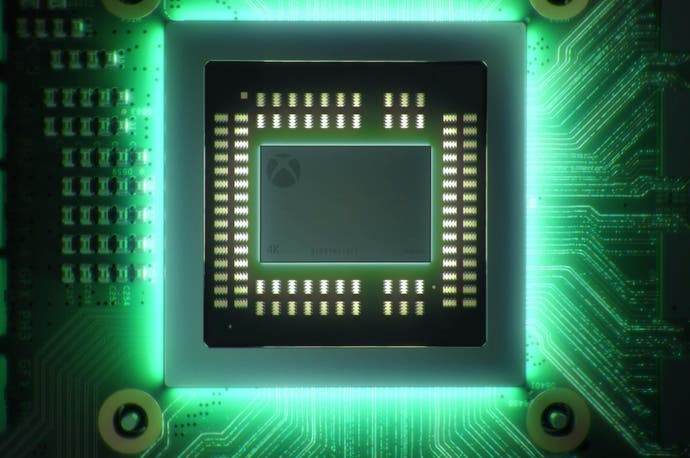Revealed: Microsoft's Xbox One X benchmarks
Native 4K vs 900p/1080p on Xbox One - plus back-compat metrics.
We were hoping that E3 would be the venue to put to rest the question of Xbox One X's raw gaming potential, but only a handful of native titles were revealed - and as such, some degree of scepticism surrounds Microsoft's 'true 4K' claims. In the wake of the event, developers have come forward to talk about impressive results with the system: Monolith has confirmed native 4K for Shadow of War, while Respawn Entertainment says that Titanfall 2 dynamically scales up to 6K resolution. On top of that, Ark developer Studio Wildcard likens Xbox One X to a PC running a GTX 1070 with 16GB of RAM. Microsoft is bullish on the machine's native 4K credentials, with its own early benchmarks painting a compelling picture of the hardware's capabilities.
We're publishing those metrics today, but they need to be put into context. Our visit to Microsoft's Redmond campus at the end of March was sandwiched between two Microsoft 'XFest' developer events - one held in the UK a week before our visit, and another held in the US just after. David Cook, a software engineer at Microsoft's Advanced Technology Group (ATG) presented a detailed low-down of the Scorpio Engine GPU, covering many of the same details found in our Project Scorpio/Xbox One X hardware reveal - but bolsters the specs with detailed performance profiling. Despite talking to us exclusively about the hardware previously, Microsoft did not provide these numbers - we sourced them via developer contacts and we further verified them before publishing.
It's a fascinating insight into the performance characteristics of the Scorpio Engine. In addition to the data, the presentation reveals how GPU bottlenecks shift somewhat in the move from Xbox One to Xbox One X - compute power is a defining limitation of the base system, but in many scenarios, this shifts to memory, geometry or pixel limits on the new hardware, necessitating a change in direction from the developer. The focus shifts back to compute - an area where the Scorpio Engine excels. Happily, Microsoft also appears to advocate a move from 4x to 8x anisotropic texture filtering too, very important in getting the most out of an ultra HD presentation.
Captures from Microsoft's performance analysis tool - PIX - were used to illustrate performance bottlenecks, with further captures used to demonstrate Xbox One X's resolution scalability. The data from nine titles was revealed, a mixture of games out now or still in development. You can see the table below with all of the information that was shared. It's sure to provoke plenty of guessing games in terms of what the titles actually are. We can be reasonable confident that titles B and C are Forza Motorsport 7 and Gears of War 4 respectively, while only Star Wars Battlefront possesses Title H's attributes. If we had to speculate, ReCore would be a likely candidate for Title A and Halo Wars 2 for Title G, but it really is speculation. The point is not so much what the games are, but how they scale on Xbox One X hardware compared to their performance on the basic model.
To get these PIX metrics, all of the titles underwent the most basic of ports onto Project Scorpio development hardware - and this presents challenges in terms of getting data representative of final games. Firstly, an early iteration of the operating system was in place, while Scorpio-specific hardware features are entirely unused. Furthermore, ESRAM from the base Xbox One is mapped directly to GDDR5 in the new console with no tweaking - meaning that there will be plenty of read/writes between memory areas that are entirely wasteful and would not happen in a shipping title. On the flip-side though, these are entirely GPU-based benchmarks - meaning that memory contention issues between CPU and GPU aren't factored in. However, this applies for both base Xbox One and X performance.
Also worth bearing in mind is that these PIX results represent a single 'snapshot' of GPU activity - and GPU load varies dramatically throughout any given game. However, we can assume that they were chosen by Microsoft to be representative of how games scale from base Xbox One hardware to Xbox One X. While we've converted the metrics to frame-rate from the original frame-time (in order to make the information easier to absorb - original data is included as well in the charts below), it should be pointed out that this data is based on GPU time alone, and stands apart from any frame-rate cap the final title may implement. So for example, frame-time on Title B (almost certainly Forza Motorsport 7) is 13ms on Xbox One and 11ms at 4K on Xbox One X. An 11ms frame-time would translate to 90fps but obviously the final game locks to 60fps - as we know, Turn 10 will be using that overhead for improved visuals on the new console.
The presentation states that the design goal of Xbox One X was to run native 1080p titles with a 4x resolution boost, while during our visit, Microsoft had expanded the objective, saying that it wanted both 900p and 1080p game engines to run at 2160p. The data for most of the nine titles clearly demonstrates that the 4x resolution design goal is clearly met - even without access to new GPU features of the Xbox One X hardware. While the 900p scaling doesn't quite show the same kind of cut and dried improvement, two out of the three basic ports get there - or thereabouts - with hardware-specific optimisation likely to make up the difference.

| Genre | Target | Engine | API | Status (March '17) | |
|---|---|---|---|---|---|
| Title A | Open World Adventure | 900p30 | Unity | DX11 | Shipped |
| Title B | Sports/Racing | 1080p60 | In-House | DX12 | Development |
| Title C | Linear Shooter | 1080p30 | Unreal Engine 4 | DX12 | Shipped |
| Title D | Open World Action | 900p30 | In-House | DX11 | Development |
| Title E | Open World Multiplayer | 900p30 | Unreal Engine 4 | DX12 | Development |
| Title F | Sports/Racing | 1080p60 | In-House | DX11 | Development |
| Title G | Multiplayer Strategy | 1080p30 | In-House | DX11 | Shipped |
| Title H | First-Person Shooter | 720p60 | In-House | DX12 | Shipped |
| Title I | Open World Action | 1080p30 | In-House | DX12 | Development |
Assuming Titles B and C are indeed Forza Motorsport 7 and Gears of War 4 respectively, we have real life parallels here between initial port data and optimised results present at E3. Turn 10's engine is indeed capable of hitting 60 frames per second with milliseconds to spare and with frame render time of 11ms, we get the 65 per cent GPU load from a title aiming for 60fps - precisely what we saw with the ForzaTech demo based on an older iteration of the engine. With that in mind, we're curious as to what upgrades Turn 10 has decided to deploy here compared to the basic Xbox One - certainly, texture filtering is looking great on the demo we've played.
Arguably more fascinating is Gears of War 4. There is overhead in the leap to 4K based on the benchmarks, but not a huge amount of it - not compared to Forza, at least. However, The Coalition announced upgrades for the game at E3 including higher resolution textures, higher polygon counts, longer draw distances, upgraded dynamic shadows and improved reflections. It's hard to believe that all of those could be accommodated in the relatively small render time improvement seen here, suggesting that more intensive optimisation for Xbox One X improves upon the raw benchmark result significantly.
And if that's the case, two of the three 900p titles tested here could conceivably attain native 4K resolution upgrades - Title A is just 1ms away from parity with base Xbox One, while Title E is just 2ms off pace, frame-times increasing by around five to six per cent in both cases. Clearly not every game will scale along those lines though. Title D - an open world adventure - clearly isn't going to make it. Perhaps coincidentally, open world adventure Assassin's Creed Origins made it to E3 running on Xbox One X hardware and producing a 2160p output, but requiring checkerboard and dynamic scaling to get there. The results still look impressive in motion though, clearly.
There's also been a certain amount of validation for Title H - almost certainly Star Wars Battlefront running on the Frostbite engine. Clearly a 720p title on base Xbox One isn't going to make it to native 4K on Xbox One X. The raw metrics here suggest that what was originally a 60fps experience would linger in 38fps territory - not surprising, bearing in mind we're looking at 9x increase in resolution. It's a topic we've discussed recently on how Xbox One X's arrival is good news for PS4 Pro. We speculated that the Frostbite team would adapt its Pro strategies for the X, and based on our analysis of Anthem, running at 2160p checkerboard on Microsoft's new console at the E3 media briefing, that's exactly what happened behind the scenes.
Beyond that, there are a couple of curiosities in the benchmarks - specifically, Title I - an in-development open world action game using an in-house engine based on DX12. Frame-times on base Xbox One hardware are measured at a staggering 59ms, suggesting that this section of game was profiled running at just 17 frames per second. There are gains running at native 4K on Xbox One X, and its performance does seem to be GPU-limited - if the CPU were an issue, the scaling would be far more limited in the back-compat results seen below.
In the documents we've seen, Microsoft provides like-for-like resolution data between base hardware and Xbox One X running at the same resolution. This may not seem particularly useful in and of itself - aside, perhaps, from revealing the staggering amount of GPU overhead available to developers if they decide to stick to the same resolution. However, this data does tie into the backwards compatibility functions Xbox One X has with existing Xbox One titles.
Looking at the table below, you'll see comparison data for Xbox One titles, along with how they run on X hardware based on two scenarios: whether they were compiled on the latest XDK development environment, or using an older one (essentially all existing titles). The Xbox One X native data represents titles compiled with the July 2017 XDK (in development when this presentation was made). Under the later XDK, every new Xbox One title will automatically gain Xbox One X performance improvements, seemingly even if the developer does not have access to an Xbox One X devkit and is targeting no bespoke improvements. As the data reveals, compiling with the new XDK represents a big improvement over older titles. So, what's going on here? Why aren't older titles compiled with older XDKs matching the results of the newer iteration?
Well, it turns out that compatibility with older games isn't a walk in the park, so pre-existing Xbox One titles default to a different set-up. In effect, half of the render back-end hardware is disabled and pixel and vertex shaders are each hived off to half of the 40 available compute units. It's a somewhat gross generalisation, but you could say that older games effectively get access to 3TF of power compared to the 1.31TF in the older Xbox One, and compared further to the 6TF accessible via the July XDK. As the improvements in render time demonstrate, pre-existing titles should get enough extra horsepower to max dynamic resolution titles and ramp up anisotropic filtering. Other back-compat enhancements promised by Microsoft - improved loading times, faster CPU power, RAM cache etc - are not GPU dependent so out of the scope of these metrics but there's no reason to believe that they will not be delivered.
In this sense, Microsoft's implementation for compatibility - halving GPU resources, effectively - may also explain PS4 Pro's boost mode, where only the clock-speed increase seems to make any difference in purely GPU-bound scenarios. Perhaps a similar utilisation of the expanded GPU was in place there - the difference being that even with the same limitations, Xbox One X has the advantage of many more compute units, plus a much higher clock.
We're really looking forward to testing this out. In the absence of an Xbox One X patch, Halo 5 should be a fascinating test of back-compat functions and how the power impacts dynamic scaling. We'll also be wheeling out our perennial hardware upgrade test titles including Project Cars and Just Cause 3. Microsoft also suggests that developers utilise the latest XDK for patch updates of older games, even if there are no plans for specific Xbox One X features - and by default, this should automatically unlock the full 6TF of GPU power for the title.
There's more too, based on the documentation we've seen. The fundamental architecture of the Xbox One X GPU is a confirmed match for the original machine (believed to be the case for PS4 Pro too) with additional enhancements. There are other features, including AMD's delta colour compression, which sees performance increases of seven to nine per cent in two titles Microsoft tested. DCC is actually a feature exclusive to the DX12 API. In fact, DX11 moves into 'maintenance mode' on Xbox One X, suggesting that Microsoft is keen for developers to move on. There are benefits for both Xboxes in doing so - and there may be implications here for the PC versions too. We could really use improved DX12 support on PC, after all.
Microsoft's key advice for developers? Expect an easy port to Xbox One X with a baseline 4x resolution boost, start with your high-end PC settings, use the memory well and fill any extra frame-time with additional effects. Guard carefully against increased loading stalls and - yes - consider techniques like checkerboard rendering and dynamic resolution. We've certainly seen representation of the latter techniques already, but as we move closer to Gamescom and the run-up to the Xbox One X launch, these early benchmarks are fascinating - and how the scaling demonstrated here translates into final shipping software should be fascinating to track once we have hardware and games to test.
















